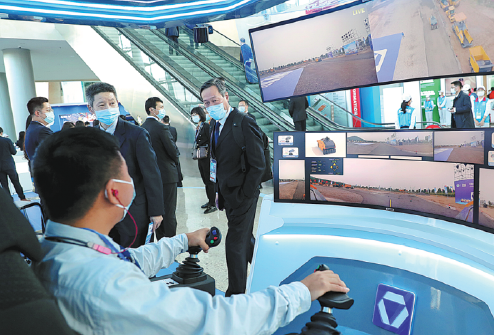At the second United Nations (UN) Global Sustainable Transport Conference held not long ago in
Beijing, China brought visitors closer to its new achievements in promoting sustainable transport
through several demonstration projects at the interactive experience zone of the conference.
These projects showed how smart port realizes such functions as remotely controlling port
machinery via 5G network, intelligent cargo sorting, and unmanned horizontal transport, 5G-based
control cabinet for online chauffeur service remotely controls self-driving vehicles, and electronic
fences standardize the parking of shared bikes by requiring payment inside the fences.
Transport industry plays a fundamental, leading and strategic role in the development of a
country’s economy, and transport services represent an important part of the service sector.
China has built the world’s largest high-speed railway network, expressway network, and world-
class port clusters, and opened air and sea routes that reach all parts of the world. The country is
now home to an integrated transport network that exceeds six million kilometers.
However, it should be noted that as the demand for transport services rises continuously, problems
concerning resources, energy and environment are becoming prominent. Therefore, the realization
of sustainable development in the transport industry bears great significance to both the transport
industry itself and high-quality economic and social development.
In recent years, China has ramped up efforts to accelerate the integration of emerging
technologies, including 5G, big data and artificial intelligence (AI), into transport services,
injecting strong impetus into the sustainable development of the transport sector.
Digital and intelligent transformation is becoming a new highlight of China’s transport sector,
with new business forms and models as well as new technologies more and more widely used to
serve people’s travel needs and facilitate the circulation of goods.
Chinese people have been increasingly benefited from upgraded facilities, new services and
innovations such as smart road network, smart port, smart shipping, online car-hailing service,
shared bikes, car-pooling service, security check system with facial recognition technology,
paperless e-boarding passes, delivery service provided by unmanned aerial vehicles, contactless
delivery service, smart parking service, as well as customized bus routes.
Contributing to about 10 percent of the carbon emissions in China, transport industry is a key
sector for the country’s efforts to save energy and reduce greenhouse gas emissions, according to
relevant data.
Upholding the idea of green development throughout the construction, operation and management
of transport infrastructure, China has achieved tangible fruits in promoting energy conservation
and carbon reduction in its transport sector in recent years.
The country’s Beijing Daxing International Airport, which utilizes renewable energy through
ground source heat pump and photovoltaic power generation, is a 100-percent green building,
according to an executive of the airport, who explained features of the airport to visitors at the
interactive experience zone of the second UN Global Sustainable Transport Conference with the
help of an eye-catching 3D sand table of the airport.
The airport is a vivid reflection of the green and low-carbon development of China’s transport
industry.
In recent years, the country has made great efforts to boost the development of green means of
transportation, including new energy vehicles and public transport systems, promote the
coordinated development of multimodal transport, optimize and adjust transport structure, recycle
waste materials including pavement surface materials, steel products, and cement, reduce express
packaging waste and make packaging products greener and more recyclable.
From actively advancing the construction of transport facilities in countries along the routes of the
Belt and Road Initiative to speeding up the connection of its road network to that of its
neighboring countries and launching the China-Europe freight trains that can reach over 170 cities
in Europe, China has always worked hard to strengthen both hard connectivity of infrastructure
and soft connectivity of institutions and rules around the world, contributing its wisdom and
strength to global transport cooperation and governance.
Today, the future and destiny of countries are closely linked and their interests entwined like never
before. Only by pooling the wisdom and strength of all and further promoting global transport
cooperation can countries better realize unfettered flows of trade and investment and facilitate
interactions between civilizations through connectivity of infrastructure.



